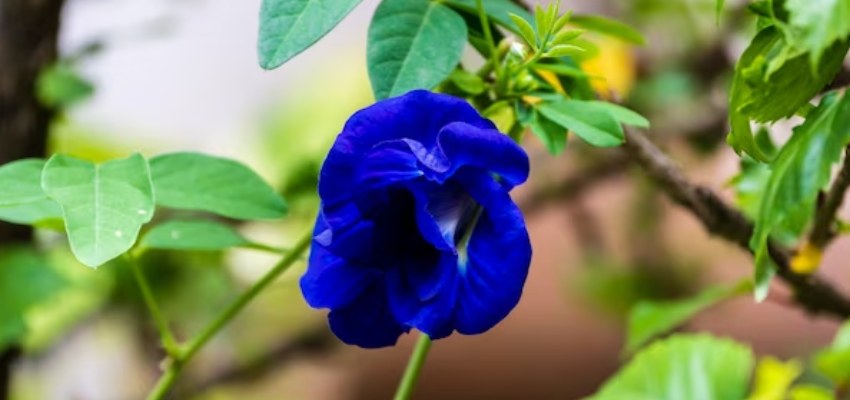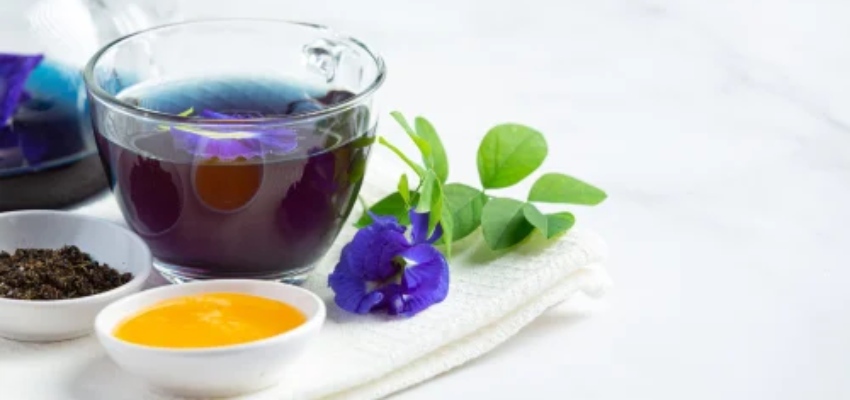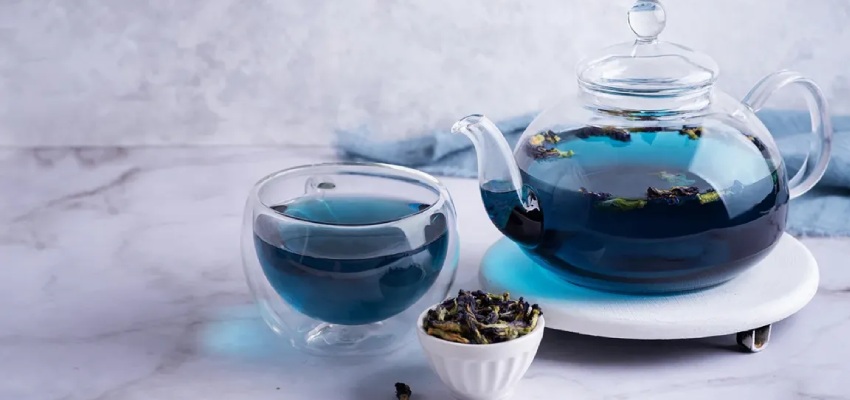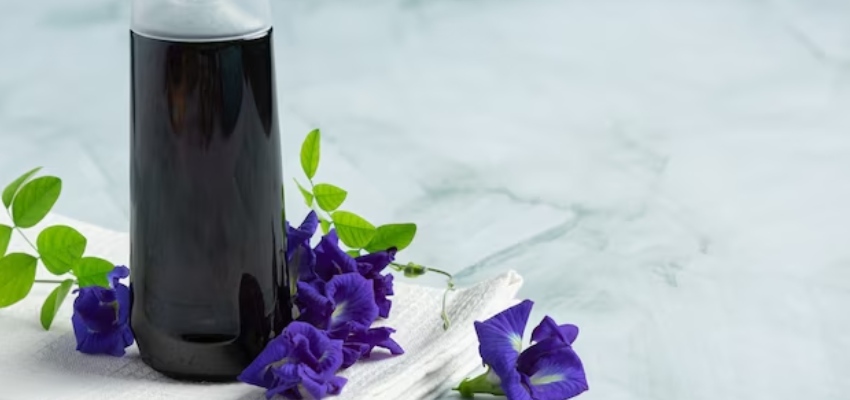The Aparajita flower, sometimes called Butterfly Pea or Clitoria Ternatea, is undeniably one of nature’s many beauties that never fails to astonish us.
The advantages of this beautiful flower extend well beyond its aesthetic appeal, touching on many facets of health and well-being. In this article, we’ll learn all about the Aparajita flower, including how to utilise it, what to watch out for, and the most effective ways to ingest it.
Unveiling the Aparajita Flower
The Aparajita flower’s vibrant blue hue has made it a popular ornamental plant in India and other tropical parts of Asia. The term “Aparajita” comes from the Sanskrit word for “undefeated” or “unconquered,” which is a fitting description of its unyielding strength.

The flower, which is found on a perennial herbaceous vine, has been used for ages as a mainstay in Ayurveda and Thai herbal treatment.
Also read about – Healing Wonders of Panchakarma
Benefits of the Aparajita Flower
The antioxidants found in Aparajita flowers effectively neutralise harmful free radicals, keeping cells healthy. This feature can assist in delaying the ageing process, lowering the likelihood of developing chronic illnesses, and improving general well-being.

It has been theorised that the flower possesses nootropic characteristics that boost mental acuity, memory, and general cognitive performance. It has the potential to boost cognitive performance by increasing neurotransmitter activation.
Aparajita flowers have long been utilised for their anti-inflammatory properties. Arthritis sufferers, people with chronic joint discomfort, and those with inflammatory skin disorders may all benefit from this.
The flower has been studied for its potential to aid in the body’s adaptation to stress and in maintaining a state of homeostasis. Stress and anxiety levels could be lowered with consistent use.
The anthocyanin chemicals found in Aparajita flowers are beneficial to hair and skin health by increasing collagen formation. By increasing elasticity and moisture, they help hair and skin stay in good condition.
Aparajita flowers have been used in traditional medicine to ease digestive issues including bloating and indigestion. As a moderate laxative, they may help regular bowel motions.
The proanthocyanidin chemicals found in this flower have been shown to have potential benefits for eye health, including the reduction of oxidative stress on the retina and enhanced blood flow to the eyes.
You should also know – Brahmi Benefits Uses
Versatile Uses of Aparajita
One of the most common uses for Aparajita flowers is to make herbal tea out of them. The addition of lemon or lime juice transforms the tea’s blue hue into a stunning purple hue. The tea is appealing to the eye, but its health advantages, like antioxidant support and relaxation, are just as appealing.

The brilliant blue of Aparajita blooms makes them a suitable natural food colouring. Without the use of artificial dyes, it may give foods, baked products, and drinks a fascinating new colour.
Delectables: The Aparajita flower is often used in Asian cooking as a flavouring agent. It is commonly used to provide colour and a slight earthy taste to rice-based dishes, curries, and desserts.
Because of its high antioxidant content and ability to increase collagen production, this flower is a great complement to skincare programmes. Oils, lotions, and masks enriched with aparajita can help skin look and feel younger and more luminous.
Here is best rose water brands in india.
Precautions and Considerations
Even though the Aparajita flower has a wealth of advantages to give, it is imperative that extreme caution be exercised and that the following safety measures be adhered to at all times:

Allergic responses are always a potential whenever a natural material is involved because of the presence of allergens. Before applying Aparajita items to the skin topically or ingesting them, it is best to first do a patch test.
Pregnancy and Lactation: Women who are pregnant or who are nursing should talk to their doctor before introducing Aparajita products into their daily routine. The supplement’s effects during these life stages have yet to be well researched.
Interactions with Medications: If you are currently taking medications, particularly those that have anti-coagulant or anti-platelet properties, you should speak with a medical professional before adding Aparajita products to your routine because there is a possibility that these products will interact with your current medications.
Consume in moderation: despite the potential health benefits of Aparajita tea and related items, you should steer clear of overindulging in either. Moderation is essential to enjoy the advantages of something without incurring any potential drawbacks.
You may also like to read about – Wheatgrass Powder Benefits
How to Consume Aparajita

Aparajita Tea:
Ingredients: A handful of Aparajita flowers, hot water, honey (optional), lemon or lime juice (optional).
Instructions: Place the flowers in a cup and pour hot water over them. Allow the flowers to steep for 5-10 minutes, releasing their vibrant color and beneficial compounds. Add honey and lemon/lime juice to taste. Enjoy the calming effects of this antioxidant-rich tea.
Aparajita-Infused Oil:
Ingredients: A handful of dried Aparajita flowers, carrier oil (such as coconut or jojoba).
Instructions: Place the dried flowers in a glass jar and cover them with the carrier oil. Seal the jar and let it sit in a cool, dark place for about 2-4 weeks, shaking it gently every few days. Strain the oil and use it for massages or as a moisturizer.
Culinary Creations:
Ingredients: Aparajita flowers (fresh or dried), rice, curries, desserts.
Instructions: Add fresh or dried Aparajita flowers to rice dishes, curries, or desserts for a visually appealing and subtly flavored twist. The flowers can be used in their natural form or steeped in warm water to release their color before adding to dishes.
Natural Food Coloring:
Ingredients: Fresh Aparajita flowers.
Instructions: Blend fresh Aparajita flowers with a small amount of water to create a paste. Strain the paste to obtain the vibrant blue liquid, which can be used as a natural food coloring in various culinary creations.
Also consider reading the ashwagandha a herbal remedy for stress.
Conclusion
The Aparajita flower exemplifies nature’s bounty by providing a wide range of advantages that include improved brain function, antioxidant protection, and improved skin quality, among other things.
Its flexibility to several areas of our life is demonstrated by the wide range of applications, from teas to skincare products.
Aparajita, like any other natural treatment, should be used with caution and moderation. By welcoming this botanical miracle into our lives, we may take advantage of its healing properties while remaining mindful of its potency.
Consider reading –
- Headache Relief Finding the Best Tablet
- Fatty Liver Symptoms Treatment
- Fever Medicine Pill
- Best Cold Tablets Name List in India